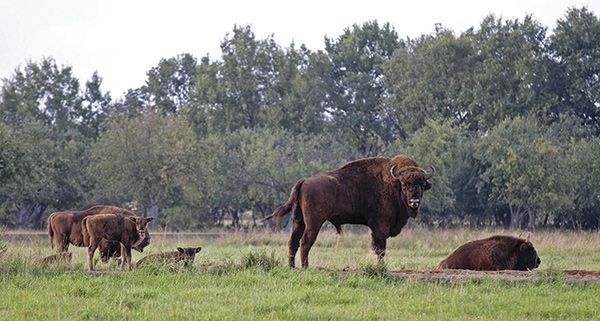
Aurochs in the Pushcha feel at home
In 2009, the Belovezhskaya Pushcha celebrated the 600th anniversary of its reserve status. Originally, it guarded against poaching, while offering luxury hunting to the elite. Yet, in 1803, the auroch was declared a protected animal in the Pushcha. At the beginning of the First World War, 727 aurochs were counted. However, several years of war took their toll, with fauna destroyed, and trees felled for export to Germany. The last female auroch was killed on April 12th, 1919 and, for ten years, the Pushcha was without a single bison. Can you imagine? Work to return the giants to the forest began in 1929 (pure bred aurochs remained only in zoos, in Poland, the UK, Sweden and Germany). An auroch breeding ground was built. Then, in 1939, war against split the Pushcha into two.
In 1946, another auroch breeding ground was launched, this time on the Belarusian side. A year later, Russian zoologist Mikhail Zablotsky offered to move its inhabitants to Moscow, arranging a park. However, Belarusians defended their Pushcha’s right to have aurochs. After all, it had been home to the last wild population.
In 1953, aurochs from Belarusian and Polish breeding grounds were released into the forest, with success. The Pushcha’s modern eco-museum is home to a very special stuffed auroch: one of the first used for breeding, during the recovery period.
Thanks to the efforts of a large number of people, the third largest herd of aurochs has been created in the Pushcha. According to recent estimates, in winter, there were 480 animals. However, this figure is rather disturbing, since it is more than the reserve can feed. Every year, about $200,000 is spent on supplementary fodder, but still there is not enough food for the herd. Sadly, our hungry aurochs have raided crops near the Pushcha, to the consternation of village residents, who beat pots and shoot in the air to scare them away.
Alexei Bunevich, a zoologist studying aurochs in the Pushcha, is concerned over our loss of biological diversity. To remedy the situation, there are plans to set up a scientific and breeding centre for the study, preservation and sustainability of the auroch population, in the Belovezhskaya Pushcha. Its main purpose is stock breeding. Unfortunately, Russian colleagues have refused to participate, due to lack of funds. “We’re looking for sponsors,” says Mr.Bunevich, hoping that plans to establish the Nikor Centre will come to fruition.
Over a period of seventy years, 270 animals have been sent abroad from the Pushcha, resettled in new homes. This work conintues, with several animals heading to the Smolensk Lakes Park in Russia at the end of this year, to create free-roaming herds.
It’s not hard for tourists to catch a glimpse of the auroch, thanks to a camera at the self-feeding station in Poland and trail cameras within the Belarusian part of Pushcha. These even have ‘night vision’, catching all forest inhabitants. You never know when you might meet an auroch, or a deer, or even a wild boar. It’s a real thrill!
1,428 aurochs live in Belarusian forests countrywide, though hard to imagine 70 years ago. Soon, aurochs may leave the pages of the Red List of Threatened Species. They’re already feeling cramped.
By Valentina Kozlovich











